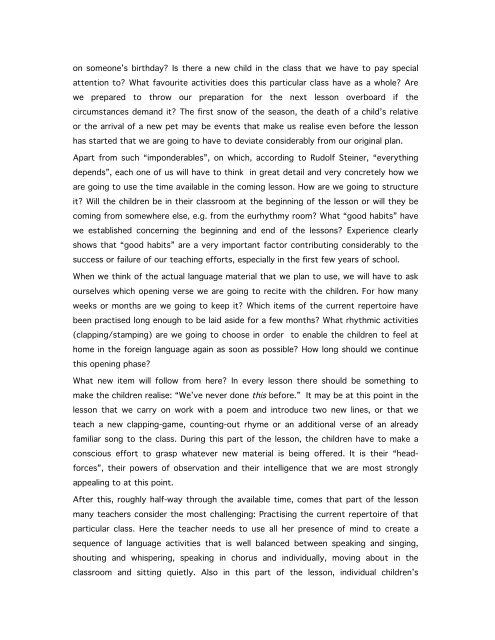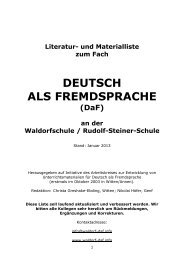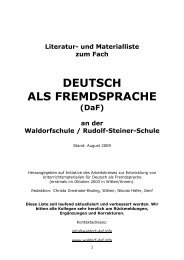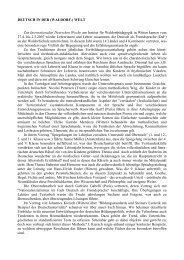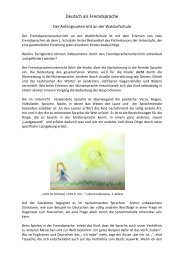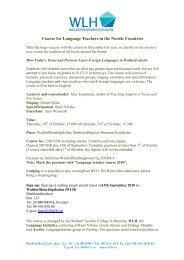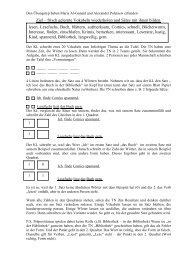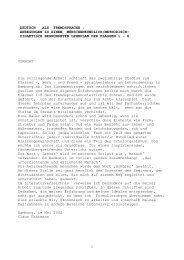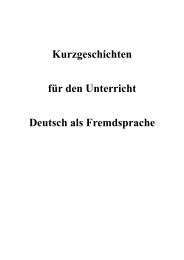Foreign Languages in Steiner Waldorf Education - Waldorf-DaF
Foreign Languages in Steiner Waldorf Education - Waldorf-DaF
Foreign Languages in Steiner Waldorf Education - Waldorf-DaF
You also want an ePaper? Increase the reach of your titles
YUMPU automatically turns print PDFs into web optimized ePapers that Google loves.
on someone’s birthday? Is there a new child <strong>in</strong> the class that we have to pay special<br />
attention to? What favourite activities does this particular class have as a whole? Are<br />
we prepared to throw our preparation for the next lesson overboard if the<br />
circumstances demand it? The first snow of the season, the death of a child’s relative<br />
or the arrival of a new pet may be events that make us realise even before the lesson<br />
has started that we are go<strong>in</strong>g to have to deviate considerably from our orig<strong>in</strong>al plan.<br />
Apart from such “imponderables”, on which, accord<strong>in</strong>g to Rudolf Ste<strong>in</strong>er, “everyth<strong>in</strong>g<br />
depends”, each one of us will have to th<strong>in</strong>k <strong>in</strong> great detail and very concretely how we<br />
are go<strong>in</strong>g to use the time available <strong>in</strong> the com<strong>in</strong>g lesson. How are we go<strong>in</strong>g to structure<br />
it? Will the children be <strong>in</strong> their classroom at the beg<strong>in</strong>n<strong>in</strong>g of the lesson or will they be<br />
com<strong>in</strong>g from somewhere else, e.g. from the eurhythmy room? What “good habits” have<br />
we established concern<strong>in</strong>g the beg<strong>in</strong>n<strong>in</strong>g and end of the lessons? Experience clearly<br />
shows that “good habits” are a very important factor contribut<strong>in</strong>g considerably to the<br />
success or failure of our teach<strong>in</strong>g efforts, especially <strong>in</strong> the first few years of school.<br />
When we th<strong>in</strong>k of the actual language material that we plan to use, we will have to ask<br />
ourselves which open<strong>in</strong>g verse we are go<strong>in</strong>g to recite with the children. For how many<br />
weeks or months are we go<strong>in</strong>g to keep it? Which items of the current repertoire have<br />
been practised long enough to be laid aside for a few months? What rhythmic activities<br />
(clapp<strong>in</strong>g/stamp<strong>in</strong>g) are we go<strong>in</strong>g to choose <strong>in</strong> order to enable the children to feel at<br />
home <strong>in</strong> the foreign language aga<strong>in</strong> as soon as possible? How long should we cont<strong>in</strong>ue<br />
this open<strong>in</strong>g phase?<br />
What new item will follow from here? In every lesson there should be someth<strong>in</strong>g to<br />
make the children realise: “We’ve never done this before.” It may be at this po<strong>in</strong>t <strong>in</strong> the<br />
lesson that we carry on work with a poem and <strong>in</strong>troduce two new l<strong>in</strong>es, or that we<br />
teach a new clapp<strong>in</strong>g-game, count<strong>in</strong>g-out rhyme or an additional verse of an already<br />
familiar song to the class. Dur<strong>in</strong>g this part of the lesson, the children have to make a<br />
conscious effort to grasp whatever new material is be<strong>in</strong>g offered. It is their “head-<br />
forces”, their powers of observation and their <strong>in</strong>telligence that we are most strongly<br />
appeal<strong>in</strong>g to at this po<strong>in</strong>t.<br />
After this, roughly half-way through the available time, comes that part of the lesson<br />
many teachers consider the most challeng<strong>in</strong>g: Practis<strong>in</strong>g the current repertoire of that<br />
particular class. Here the teacher needs to use all her presence of m<strong>in</strong>d to create a<br />
sequence of language activities that is well balanced between speak<strong>in</strong>g and s<strong>in</strong>g<strong>in</strong>g,<br />
shout<strong>in</strong>g and whisper<strong>in</strong>g, speak<strong>in</strong>g <strong>in</strong> chorus and <strong>in</strong>dividually, mov<strong>in</strong>g about <strong>in</strong> the<br />
classroom and sitt<strong>in</strong>g quietly. Also <strong>in</strong> this part of the lesson, <strong>in</strong>dividual children’s


